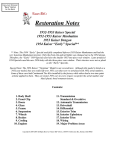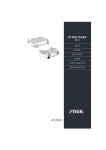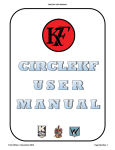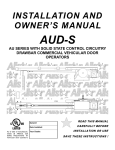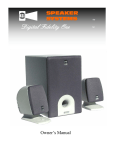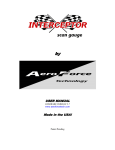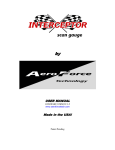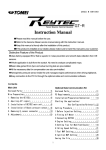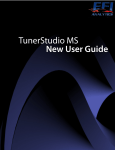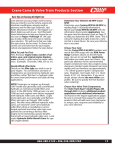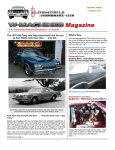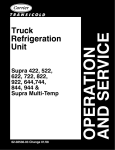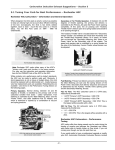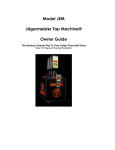Download Restoration Notes
Transcript
Restoration Notes 1954-1955 Kaiser Manhattan 1954 Kaiser “Early” Special** 1954 Kaiser “Late” Special ** Note: The 1954 “Early” Special used fully completed leftover 1953 Kaiser Manhattans and had the very luxurious Manhattan interiors. Only the front clip and tail lights was changed out to the 1954 design. Therefore, the “Early” 1954 Specials also have the smaller 1953 one-piece rear window. Later produced 1954 Specials used the new 1954 body with the three-piece rear window. Their interiors were not as plush as the “Early” Specials. Contents: 1. Body Shell 2. Front Clip 3. Doors 4. Glass 5. Frame 6. Suspension 7. Wheels 8. Brakes 9. Cooling 10. Engines 11. Transmission Standard & Overdrive 12. Automatic Transmission 13. Driveshaft 14. Differential 15. Exterior Trim 16. Interior Upholstery 17. Interior Trim 18. Wiring 19. Major Problem Areas Copyright © 2005-2007 All Rights Reserved “Kaiser Bill” Brown, 18530 W. Yellowstone Rd., Altonah, Utah 84002 PREFACE I have complied these “Restoration Notes” in order to provide some guidance to those who own these unique American automobiles and for those who may be contemplating purchasing one. The Kaiser automobiles were some of the most unique and quality American cars of the 1950's and are a very pleasurable car to own, restore, show or drive. They turn heads every where they go and their beauty and uniqueness always draw a crowd. The Kaisers are not difficult to restore or maintain and most parts can be located with little effort. Most mechanical parts were obtained from outside suppliers, such as Borg-Warner, Auto-Lite, and GM, so many parts are common with other makes. The engines were built by Kaiser but, since Kaiser also owned the Jeep line, the engines were used in the Jeep as well, even long after Kaiser had sold the Jeep line to AMC, so most engine parts are not that difficult to locate. However, there are several items, especially body and trim parts, which a prospective buyer should inspect carefully since replacements are extremely difficult to locate in usable or restorable condition. There items are identified in the detailed sections. The Kaiser organization introduced many features that would later be found on other cars. Kaiser produced the first “Hatch-Back” car, the first 4-door convertible, the first post-war supercharged car, the first “Safety First” car and introduced the bright color coordinated exteriors and interiors to the automotive industry. The Kaiser automobiles were given many international awards for beauty and style. Howard Darrin who designed the streamlined 1951-1955 Kaiser body lines was a famous world-class designer who designed many of the custom bodied luxury cars of the 1930's and 1940's for the European manufacturers as well as the American car companies. His design of the was probably his most memorable. It remains one of the best-looking cars to this day and is the most sought after Kaiser model.. I have been involved with the Kaiser and Frazer Automobiles since 1946. My Dad was a KaiserFrazer-Willys Dealer from 1946 until 1956 and I worked in my Dad’s shop after school and on Saturday’s during my High School days and thereafter upon my return from military service. I now devote most of my time trying to help others by sharing what knowledge I have of these automobiles. These notes are by no means complete, and there may be some errors that I have not recognized, but I hope these “Restoration Notes” will be helpful to those who read them. NOTE: There are several sources of interchange parts lists, including the Hollander Interchange Manual. All of the known lists are helpful but none are totally accurate or complete for the Kaiser cars. Copyright © 2005-2007 All Rights Reserved “Kaiser Bill” Brown, 18530 W. Yellowstone Rd., Altonah, Utah 84002 1. Body Shell: 4-Door Sedan Models - The 1954-55 4-door Manhattans and 1954 4-door “Late” Specials shared the same body. As previously noted, the 1954 “Early” Specials were actually left-over 1953 Manhattans so they share the same body as the 1953. The new 1954 body was basically the same as the 1951-1953 4-door body except for the rear window opening. The front bumper splash shield are unique to the 1954 body. The rear splash shields were the same as the 1953 models. The stainless bottom side trim mounting holes were drilled differently for the Specials and the Manhattans. 2-Door Sedan Models - The 1954 2-door Manhattans and “Late” Specials shared the same body. The 1954 “Early” Specials used the 1953 body. It was basically the same as the 1951 2-door body except for the very minor differences in tail light drilling. The stainless bottom side trim mounting holes were drilled differently for the Specials and the Manhattans Club Coupe - There were no 1954 or 1955 Club Coupes produced. Note: The 1951 thru 1955 Kaisers were praised as the best looking American car. It was awarded many international awards for its beauty of design. Many of the exterior features of the 1951 thru 1954 Kaisers would soon be copied by every US car manufacturer. The rear fender “Darrin Dip” would first be copied by Chevrolet for the “new” 1955 Chevrolet. Almost every US car maker would soon copy this “Dip.” Ford would be the next to copy the “Dip” for the 1965 Mustang, Most others would soon follow. The rear window backward slant was also copied by many. The front and rear window “Sweetheart” shape would remain a unique Kaiser design feature. Traveler - There were no 1954 “Hatch-Back” Travelers produced Note: Kaiser produced the world’s first “Hatch-Back” in 1949. This original Kaiser design was personally ordered built by Henry J. Kaiser himself. There is a interesting story as to the event that prompted Henry Kaiser to order this model to be put into production. Parts - A limited number of reproduction body parts are available. Reproduction outer rocker panels, partial floor panels and rear fender well repair panels are available. 2. Front Clip: All 1954 and 1955 models used the same front clip and it will not interchange with earlier models. (radiator support, inner fenders, fenders, grill, bumper splash shield, hood and grill). Parts - No reproduction parts are available. Some NOS parts can be located. Copyright © 2005-2007 All Rights Reserved “Kaiser Bill” Brown, 18530 W. Yellowstone Rd., Altonah, Utah 84002 3. Doors: Doors of all 4-door cars of any of the models listed above will interchange. The doors for the 2-door cars will interchange with the previous years Club Coupe. The front door of the 4-door models will not fit the 2-door body. Parts - No reproduction parts are available. Some NOS parts can be located. 4. Glass: All glass, windshield, door windows, vent windows and rear windows are the same for all models. Note: Glass from a 1951 model will also fit except for the front windshield and rear window. The 1951's used a split 2-piece front windshield. All glass from a 1952-53 will also fit except for the 3piece rear window of the “Late Specials” and the Manhattans. Parts - Windshields are being reproduced by the Kaiser Club. The door and vent glass is flat and readily available from any competent automotive glass shop although the tint for some cars may not match exactly. The curved rear glass is only available from parts cars. 5. Frame: The X-frames for all 1951 through 1955 are basically the same and can be interchanged without any problem. Although there were some very minor differences in 1952 and again in 1954 they are just a few holes which can be drilled in the earlier frames. Note: When the 1951 Kaiser was introduced, the extremely smooth ride was quickly recognized by the buyers and envied by the other major manufactures. The car rode better than many popular and much heavier cars. Several of the other US car manufactures quietly purchased a 1951 Kaiser and stripped it down to analyze just why this Kaiser rode so smooth. They credited the smooth ride to the excellent X-frame, spring rate and the positioning of the seats. Their engineers would soon copy many features of the Kaiser design. As outlined above, they would also copy many of the exterior body design features as well. Parts - No reproduction parts are available. 6. Suspension: Front Suspension - The front suspension parts are mostly unique to the Kaiser. Minor suspension changes were made in 1952 and again in 1954 but most parts are interchangeable with the 1951 thru 1953 models. In addition many of the suspension parts are interchangeable with the earlier model Kaisers especially the 1949 and 1950 models. Some parts are identical to other US makes, such as the shock absorbers, wheel bearings and seals. Several Buick and Oldsmobile front springs will interchange but the spring rate is not identical to the Kaiser. Some parts of the A-arms also interchange with other makes but there is no reliable complete interchange list. Copyright © 2005-2007 All Rights Reserved “Kaiser Bill” Brown, 18530 W. Yellowstone Rd., Altonah, Utah 84002 Power Steering - Power Steering was offered on the 1954 “Early” Specials and the 1954-55 Manhattans.. It was not an option on the 1954 “Late” Special. The same system was used on the 1953 Manhattans and Dragons. The unit was a Monroe Linkage Type. This same system was also used on Dodge, Ford, Hudson, Mercury, Nash, Packard and Plymouth cars. Note: This power steering system was often criticized as being too sensitive. It required very little steering input and lacked the steering “feel” most customers were used to. It was easy to over-correct the car at high speed. Parts - No reproduction parts are available but any good rebuilding shop can rebuild your unit. Rear Suspension - The rear springs are unique to the Kaiser. The shock absorbers are interchangeable with other makes but there is no reliable complete interchange list. The rear differential housing is unique to the Kaiser. There were 4 different drive ratios available (see the Differential Section). Parts - Reproduction springs are available but do not match the original Kaiser spring rate. Shock absorbers are available. The differential mechanical unit is a Dana so parts are available. 7. Wheels: The Kaiser wheels are of a five-bolt 4-1/2 inch pattern. This same pattern was used by Ford in the 1950's and 60's. A few of the Chrysler products also used this bolt pattern but there is no reliable interchange list available. Since Kaiser owned the Willys Jeep line, they used the same wheel bolt pattern on the Jeep. When AMC purchased the Jeep line they continued using the same wheels until the early 1990's. Note: A good source for new “Kaiser wheels” is your local Jeep dealer. Even the 1988 Jeep special aluminum alloy wheels will fit! Parts - From your Jeep Dealer or from recycled parts cars. 8. Brakes: The front and rear drum brakes are Bendix type-4 design. The brake shoes interchange with a few Nash, Studebaker and Willys models. The brake master cylinder and wheel cylinders also interchanges with other makes. There were no Disc brake option available. Parts - Brake shoes, master cylinders, wheel cylinders, brake hardware, springs, clips, etc., are readily available. Brake drums are not being reproduced. Some NOS parts can be located but drums are available only from recycled parts cars. 9. Cooling: The radiator for all models is identical. It is the same Harrison radiator used in the 1955 -56 6-cylinder Chevrolets, except the mounting brackets are different. These can be swapped by any competent radiator shop. There was no fan shroud on any model. The water pump is identical on all models except those with power steering. It has a slightly different housing. Copyright © 2005-2007 All Rights Reserved “Kaiser Bill” Brown, 18530 W. Yellowstone Rd., Altonah, Utah 84002 Parts - Radiator cores and tanks are available. They are being reproduced for the Chevrolet. NOS water pumps may be located and rebuilt water pumps are available. Radiator mounting brackets are only available from parts cars. 10. Engine: The engine in the 1952-1955 Kaisers was a Kaiser-built engine. It is an 226 cubic inch in-line flat head 6cylinder engine. This same engine was also used in the Jeep for many years. The engines built by Kaiser and used in the 1952-54 Kaisers had “Kaiser Supersonic” script cast into the engine head. All models listed in the heading used the same engine. The 1954-55 Manhattans came with a factory-installed McCulloch Supercharger. This unit boosted the horsepower of the engine from 115 hp to 140 hp. It is very reliable and is still being built today under the “Paxton” name. It is the same unit that was used on the 1957 Studebaker “Golden Hawk” and with minor differences was the same as used on the 1957 Ford “Thunderbird.” Note: Kaiser had purchased the rights to the Continental engine back in late 1947 and redesigned it for additional power and improved reliability. The Kaiser engineers improved the crankshaft, increased the compression ratio and changed the valve timing. Earlier cars produced in 1946 and 1947 used the original Continental engine and did suffer some reliability problems. The problem was contributed to soft crankshafts. The Kaiser built engines did not have this problem. Parts - Most internal engine parts are readily available from parts suppliers. Hardest to locate are the crankshaft balancer, timing chain, crankshaft gear, camshaft gear, camshafts and camshaft bearings. The crankshaft fan belt pulley for all cars, power steering or standard, is not available except from parts cars. Crankshafts, blocks, heads, pans, and all covers are also only available from recycled parts cars. 11. Standard and Overdrive Manual Transmission: The standard transmissions and Overdrive units are common T-90 Borg-Warner type. The transmission is a synchromesh 3-speed manual unit. On the Kaiser the transmission is shifted by means of a column mounted shift linkage. The Overdrive unit provides a fourth gear with simple operation by removing the drivers foot from the gas pedal to shift up or pressing the gas pedal to the floor to shift up. The Overdrive unit provides “free wheeling” which can be disengaged by means of a dash mounted pull cable for push starting, etc. The same Overdrive unit was used on many other makes of the period. Parts - Most internal parts are readily available from parts suppliers or obtained from recycled parts cars. Most of the external shift mechanism and linkage must be rebuilt or obtained from recycled parts cars as none are being reproduced. 12. Automatic Transmission: The 1952 thru 1955 Kaisers used a GM Hydramatic ® transmission. It was almost identical to the models used in the Pontiacs and Oldsmobiles which can be used for replacements. The Cadillac Hydramatic was similar but not identical. This model of the Hydramatic transmission had a designated “Park” position. The unit used on previous Kaiser models did not. Parts - Parts are readily available and good used units are easy to locate. Copyright © 2005-2007 All Rights Reserved “Kaiser Bill” Brown, 18530 W. Yellowstone Rd., Altonah, Utah 84002 13. Driveshaft: The driveshaft consists of one balanced tubular shaft and two cross-type universal joints that are greaseable. The shaft passes through the center X-member of the frame. Parts - Parts are readily available. The universal joints are of the common type used on several other makes. Used shafts can be obtained from recycled cars or any competent driveline shop can fabricate new ones. 14. Differential: All 1952 thru 1955 Kaisers shared the identical Dana 44 differential. There were four drive ratios depending upon the model and the type of transmission installed. Although there is no written specifications it is possible a few cars may have been equipped with the earlier Dana 41. The Dana 41 can be identified by a round bolt pattern instead of the oblong pattern of the Dana 44. The four rear axle ratios available were: Transmission Rear Axle Ratio Hydramatic 3.54:1 Standard 3.90:1 Standard 4.09:1 Standard with Overdrive 4.55:1 There is a metal tag attached to the rear differential cover that lists the number of teeth on the drive gear (larger number) and pinion gear (smaller number). To determine the ration divide the larger number by the smaller number. Note: This same differential was also used on various Jeep models, at least through 1967, and Ford 4wheel drive trucks as the front differential. Parts - Parts are readily available from parts suppliers. 15. Exterior Trim: All exterior trim is unique to the specific models. The bottom stainless trim was wider on the Manhattan models and thinner on the Deluxe. The front bumper on the1954-55 cars were the same as the 1951 models. None of the 1954-55 grill parts will interchange with the earlier models. The 1954-55 hubcaps were identical to the 1953 models. Parts - Reproduction plastic emblem inserts are available for the 1954-55 models. No other reproduction exterior trim parts are available. Some NOS parts can be located. Except for plastic parts, there are sufficient parts available from parts cars. The headlight trim rings and rear fender “fin” trim for the 1954-55 cars are difficult to locate. 16. Interior Upholstery: The interior upholstery is one of the most attractive features of these cars and is unique to these specific models. The Kaiser vinyl is very sturdy and most of the original will be in reusable condition. Copyright © 2005-2007 All Rights Reserved “Kaiser Bill” Brown, 18530 W. Yellowstone Rd., Altonah, Utah 84002 Parts - There is no reproduction upholstery available. Some material may be located from parts cars but it is over 50 years old. The vinyl may be good but the cloth material is rarely usable. Note: The Dragon used special upholstery material that is unique to the Dragon only and is especially difficult to locate from parts cars. The Dragons also used two different types of padded vinyl tops that cannot be matched with known current production materials. 17. Interior Trim: All interior trim is unique to these specific model except some of the interior trim is identical to the 195153 Kaisers. Parts - There are no reproduction parts available. Some NOS parts may be located. Except for plastic parts and the Dragon dash plaque, there are sufficient parts available from recycled parts cars that can be restored and rechromed.. 18. Wiring: Parts - The Kaisers like all other cars of the 50's widely used the old cloth wrapped wire. Some of that is available but it is very difficult to match all the color combinations and wire types of the original wiring. Some partial reproduction wiring harnesses are available. In most cases you will need to furnish some of your original connectors and plugs. Kits from several aftermarket suppliers may be used but the type of wire, connectors and plugs will not match the original. The new aftermarket kits do have much improved wire and insulation and are much easier to install than to try to make your own harness. However, they will not pass as “original.” 19. Major Problem Areas: The major problem areas in restoring one of the Kaiser models listed in this section are: (1) - Locating replacement interior upholstery. Nothing is being reproduced. The Kaiser vinyl was very sturdy and most that you take from parts cars will be reusable. The cloth upholstery is another matter. After some 52 years, most of it will be unusable. You will have to search extensively in order to locate enough of the fabric. Both the vinyl and the fabric will need to be dyed to match the original color. A task not easily accomplished. As explained in the “Upholstery” section, the Dragon presents specific problems in this area. (2) - Locating replacement plastic parts, interior and exterior. The only plastic part that has been reproduced is trunk emblem insert and the supply of them is running low. All other plastic replacement parts must come from recycled parts cars or you must have them reproduced. A costly venture. Reproduction steering wheels are available from the Kaiser Club but the color is not an exact match and the rims are thicker. Copyright © 2005-2007 All Rights Reserved “Kaiser Bill” Brown, 18530 W. Yellowstone Rd., Altonah, Utah 84002 (3) - Locating the proper tinted glass. Although the Kaiser Club (KFOCI) has reproduced some windshields, the tint and shading does not correctly match the original. The curved rear windows are not being reproduced and must be obtained only from recycled parts cars. This used glass usually has minor imperfections at best. The tinted flat glass available from your local glass shop does not match the original tint color. If you replace any glass you will need to replace all of it. There are glass companies that will reproduce curved glass for you but it is very expensive and the reproduced piece does not always fit and rarely matches the original tint. (4) - Hood hinges. NOS hood hinges do show up from time to time but the Kaiser hood hinges are prone to wear badly. They rarely operate properly after two years and these cars are over 50 years old. The one company that previously rebuilt the Kaiser hinges will no longer do so. They say it just is not profitable as the labor is too extensive. They did a superb job. They used new springs and installed pins much better than the original. Your only choice now is to locate a local shop that will tackle rebuilding the hinges or try to rebuild them yourself. Be extremely careful as the spring is capable of causing severe injury. (5) - Repairing rusted areas. The Kaiser models in this listing are prone to severe rust in several areas. Bottom lip of hood, rear fender under tail lights, bottom trunk lip, front floors, rocker panels, rear fender wheel wells, interior trunk sides. Reproduction rocker panels, partial floor panels and upper rear wheel wells are available but they are not identical to the original and amounts are limited. Replacement hoods and trunks are available from recycled parts cars but most recycled ones will have some of the same rust problem. (6) - Engine. Even though the Kaiser engine is very reliable and will last over 150,000 miles in normal use, most restorers will want the engine rebuilt. The engine has soft valve seats which can easily be burned by the use of non-leaded gasoline so new hardened valve seats are a must. The Kaiser engine is not familiar to many rebuilding shops and there are several cautions that should be followed. The timing method for a rebuilt Kaiser engine is not common. It is not set to cylinder number 1 as most engines. Careful study of the Kaiser Service Manual is a must. The distributors appear identical as earlier engines and will seem to fit - but they do not. The newer type rear oil seal conversion (designed for the Jeep OHV 230 Tornado engine) should always be used but the rear filler block must be properly modified or a severe oil leak is guaranteed. If the block requires an overbore of more than 20 thousands, it is best to search for another block. In no case should the block be bored more than 30 thousands. It is best to not exceed 20 thousands. If the cylinder walls are bored too thin they will overheat and warp causing massive engine failure. Check the rods very carefully. Obtain new rods if possible as they are prone to bend. Be sure to have the cylinder block and cylinder head honed flat. Once removed from the engine the heads are prone to warp if laid flat. Stand them upright. Do not over-mill the heads. Too much will increase your compression ratio leading to a requirement to use only premium gasoline. (7) - Body Mounts and Rubber Mounting Gaskets - Reproduction rubber body mounting pads are available but are usually too thin and will need to be shimmed. Reproduction rubber mounting gaskets for some of the trim, such as hood and trunk emblems and light housings, are available but do not fit very good. A lot of time will be spent fitting the gaskets or making new ones from scratch. None of the other trim mounting gaskets are available and must be fabricated.. Copyright © 2005-2007 All Rights Reserved “Kaiser Bill” Brown, 18530 W. Yellowstone Rd., Altonah, Utah 84002 (8) - Interior and Exterior Trim - Except for the plastic part mentioned in (2), none of the Kaiser trim is being reproduced so your old parts will need to be restored and/or rechromed. Recycled parts are available but most will also need to be rebuilt as well. Other plastic parts and hubcaps are a particular problem and difficult to locate. Copyright © 2005-2007 All Rights Reserved “Kaiser Bill” Brown, 18530 W. Yellowstone Rd., Altonah, Utah 84002










